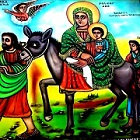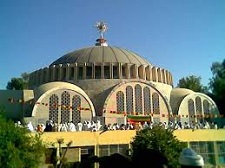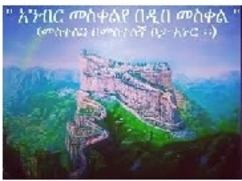Bible Study (Children & Youth)
Ethiopian Orthodox Tewahedo Church English Lessons Prepared to young families of EOTC members attending their lessons at Debre Zihon St. Mary Church Every Sunday between 10:00AM – 12:00 Noon
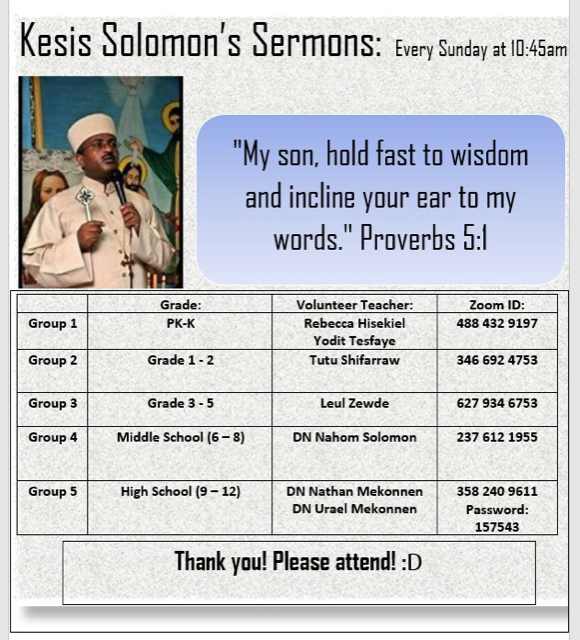 |  |
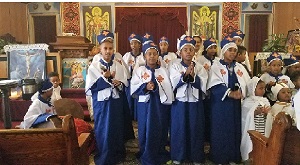
- Lessons for Level I (KG and Pre KG) Click here
- Lessons for Level II (Grades 1 ‐3) Click here
- Lessons for Level III (Grades 4 ‐6) Click here
- Lessons for Level IV (Above Grade 6) Click here
Mystery of the Holy Trinity
In this section the mystery of Unity and Trinity of the Triune God is described.
The Holy Trinity is three in name, in person (Akal), in deed and one in essence, in divinity, in existence, in will.
Three in name: – Father, Son, Holy Spirit
Three in deed:-
- the Father is the begetter
- the Son is begotten
- the Holy Spirit is the one who proceeds
Three in person:-
- the Father has a perfect person
- the Son has a perfect person
- the Holy Spirit has a perfect person
The Father is the heart, the Son is the word, the Holy Spirit is the life (breath)
The Father is the heart for himself, and He is the heart for the Son and for the Holy Spirit.
The Son is the word for Himself, and He is the word for the Father, and for the Holy Spirit.
And the Holy Spirit is the life (breath) for Himself, and He is the life (breath) for the Father and the Son.
Even though we say the Trinity are three in name in deed and in person: the three are one in essence, in divinity, in existence and in will; we do not mean three Gods but one God. While the Father and the Son and the Holy Spirit exist in their own perfect person, they are one in existence. (Abulidis, Faith of the Fathers, Ch. 40 Verse 4:6)
As Ignatius has said in the Book of the Faith of the Fathers (Haimanot Abew) the name of the Father is not changed to be the name of the Son or the Holy Spirit. The name of the Son is not changed to be the name of the Father or the Holy Spirit, the name of the Holy Spirit is not changed to be the name of the Father or the Son. The Father is called the Father but not the Son
or the Holy Spirit. The Son is called the Son but not the Father or the Holy Spirit. The Holy Spirit is called the Holy Spirit but not the Father or the Son. The Father is the Father, the Son is the Son and the Holy Spirit is the Holy Spirit. The three exist eternally in their own name and person. (Faith of the Fathers Ch. 11 part 1 verse 7, 8)
In their name of unity, the three are called Lord, God. Lord the Father, Lord the Son, Lord the Holy Spirit, One Lord. God the Father, God the Son, God the Holy Spirit, One God. The three hundred eighteen fathers in the Book of the Faith (Haimanot Abew) said, “we believe in Lord the Father, in Lord the Son, in Lord the Holy Spirit. (Faith of Fathers, Ch. 19, part 1 verse 30)
The Apostolic St. Athanasius Archbishop of Alexandria said, “The Father is God, the Son is God, the Holy Spirit is God. They are called one God but not three Gods.” (Apostolic Athanasius Faith of the Fathers, Ch. 24, part 4, verse 4) It is stated in many places in the Old and the New Testament Books about the Oneness and Trinity of the Holy Trinity.

Introduction
Background
As most Sunday School curricula peruse the Bible from a topical perspective (e.g. purity, honesty, ..etc.), coverage of the historical stories of the Bible is usually spotty. Most stories of the Bible are not covered in depth and some stories are not covered at all, because the focus is on the topic and not the Bible story. While teaching the stories from the Bible from a topical perspective is useful in presenting scripture-based life applications, it’s also important to learn the Bible stories in their natural time flow for several reasons Learning the stories in their chronological order provides a more abstract view of what the Bible is all about. This approach presents the Bible as one unit, and one story that has a beginning in Creation, a climax of the fall of man and Christ’s Salvation, a context for the Church in which we live in at the present, and an ending in the future of the Second Coming in Revelation. In addition, presenting the Bible in this way, portrays the main thread the links all the Bible stories together; namely the Word of God (Christ Jesus). Furthermore, these stories provide the building blocks upon which the other lessons like faith, salvation, ..etc. are based. For example, a lesson about faith can make use of the stories of Noah, Abraham, …etc. without the need to go into these stories in depth, since the knowledge of these stories will be attained through this curriculum.Purpose
This curriculum is meant to present the Bible in the way discussed above. The curriculum covers all the historical books of the Old Testament and the four Gospels in the New Testament. Acts of the Apostles is not covered due to the time restrictions (only 10 lessons a year). These topics are covered over a period of four years, with 10 lessons a year. The Bible stories division are based on the Calvary Bible Curriculum, compressed and spread over a 4-year cycle. Each year, the lessons cover both the Old Testament, and the New Testament.The 4-year cycle can be repeated at different levels for different age groups. The curriculum contains two 4-year cycles. The first cycle covers G1-4/5; while the second cycle covers G6-12.
Each lesson description includes the stories that need to be covered in each lesson. Ideally, the lesson provider should try to link the stories with the previous ones given, and show if possible how these stories depict Christ (in some stories this might not be obvious, though). Each lesson also contains a message and an application. These are optional, since the main purpose is to cover the stories, and not a topical Bible lesson. A memorization verse(s), is also included. Whenever possible, this verse(s), is from a Bible book different than the one presented to enforce the unity of the Bible. Since all the topics in each lesson may not be covered within one Sunday School lesson due to time restrictions, the topics that were not covered could be covered by the children at home by answering questions provided by the lesson presenter. This curriculum is not meant to be a Bible study as explained below.This curriculum is not about scholarly studying of the Bible.
As such, it does not include any lessons on the historicity of the Books taught (e.g. author, cultural context, timeline, …etc.). In some cases, the lesson presenter may want to include some historical background to shed some light on some of the events in the stories. That is left totally to the presenter according to their class needs.
Also, the curriculum is not about contemplative studying of the Bible. That is, it does not include any points of contemplation on the stories. Again, in some cases, the lesson presenter may want to contemplate on some story events. That is left to the presenter to choose according to the situation.To sum up, this curriculum in its simplest form is about telling the stories from the Bible as they are written in the Bible.
Note
This document will always be in an updating state during this yeas as lessons are taught for the first time. Some topics will need to be adjusted to suit the lesson. Some will be expanded, shortened or split as required. A new major version will be issued after significant updates.This section proposes some points on preparation and presentation of the Bible lesson to achieve maximum benefit from this curriculum. These methods are just guidelines and can be adapted differently for each class according to their needs.
- Each child needs to bring their own personal Bible. The one they use at home, and not the family Bible. If there’s a need for a Bible, the Church will provide one at no cost (the servant may encourage the child to donate from his/her allowance towards the cost of the bible so that the child may take it serious). Please contact the Sunday School Service administrators, and they will provide the needed Bibles.
- Conducting the Bible lesson should emphasize on children reading from their personal Bibles during the class, taking turns and trying to explain what they read. Servants should provide explanations for difficult parts. Some parts may need some audio/visual aids. For G3 and under, reading will be a challenge, so using more visual aids will be required. The Gospel light posters, pictures from Google, ppt slides, the Bible Society Videos or the dramatized Audio Bible are very useful resources for this age range.
- Sunday School servants should not use a pre-prepared presentation, but rather involve the children in conducting the lesson by reading from the Bible and explaining.
- As part of explaining the story from the Bible, the servant may need to prepare some background information about the story they are reading, such as; what happened before the part they are reading or some of the surrounding events, just to give the children the setting of the story they are reading. Servants may also provide a message and/or a real-life application from the story they read at the end of the lesson, as explained in the introduction section.
- If all the references given for a lesson cannot be covered due to time limitations, the rest of the references can be covered at home by the children in the form of answering questions, provided by the servants.

-
-
- Noah Builds the Ark: → Genesis 5:28-6:22
- God Sends a Great Floode: → Genesis 7:1-8:19
- God’s Covenant: → Genesis 8:20-9:17
- The Tower of Babel: → Genesis 10:8-10; 11:1-9
-
Message
God’s ultimate love for man
- He created him at the pinnacle of His creation.
- He planted a garden for him in Eden to tend to it and enjoy.
- He created a partner/helper for him (Eve).
Jesus is the Word of God Who created everything.
Who created me, my best pet, my family/friends? Every day say to God “Thank you”
Memorization
John 1:1-3

-
-
- Creation: → Genesis 1:1-2:25
- God Makes Adam and Eve: → Genesis 1:26-4:1
- The Garden of Eden: → Genesis 2:8-17
- Adam and Eve are Tempted: → Genesis 3:1-4:1
- Cain and Abel: → Genesis 4:1-17
- Enoch: → Genesis 5:18-24
-
Message
- God’s ultimate love for man
- Faith in God’s word.
- Noah’s ark is the Church

-
-
- God Calls Abra: → Genesis 11:26-12:9
- Abram and Sarai Visit Egypt: → Genesis 12:10-13:1
- Lot Leaves Abram: → Genesis 13:6-18
- Lot’s Captivity and Rescue: → Genesis 14
- God Makes a Promise to Abram: → Genesis 15:1-17:19; 18:1-16
- Hagar and Ishmael: → Genesis 16
- Abraham Bargains With God: → Genesis 18:16-33
- Sodom and Gomorrah: → Genesis 19:1-3
-
Message
The Faith of Abraham Follow Abraham’s trust in God, and trust in God in our daily lives. Memorization Gen. 15:6
-
-
- Isaac is Born: →Genesis 21:1-8
- Abraham Offers Isaac: → Genesis 22:1-18
- A Bride for Isaa: → Genesis 24:1-67
- Jacob & Esau: → Genesis 25:19-34; 27:1-46; 33
- Isaac Blesses Jacob: → Genesis 27:1-46
Message
Memorizatio Psalm 89:1 “I will sing … all generations”
-

-
-
- Jacob’s Dream: → Genesis 28:10-22
- Leah & Rachel: → Genesis 29:1-30
- The Sons of Jacob: → Genesis 29:31-30:24; 35:16-26
- Your Name Shall Be Israel: → Genesis 32:22-32
-

-
-
- Joseph is Sold by His Brothers: → Genesis 37:3-36
- Joseph & Potiphar: Genesis: → 39:1-23
- Joseph in Prison:→ Genesis 40:1-41:57
- Joseph Tests His Brothers: → Genesis 42:1-44:34
- Joseph Reveals Himself to His Brothers: → Genesis 45:1-16
- Jacob Moves to Egypt: → Genesis 45:17-50:26
-

-
-
- The Slavery of the Israelites: → Exodus 1:1-14; 2:23-24
- Moses is Born: → Exodus 2:1-10
- The Burning Bush: → Exodus 3:1-4:17
- The Ten Plagues: → Exodus 7:14-11:10;12:29-30
- The First Passover: → Exodus 12:1-28
- The Exodus: → Exodus 12:31-51
- Crossing the Red Sea: → Exodus Exodus 14
-

